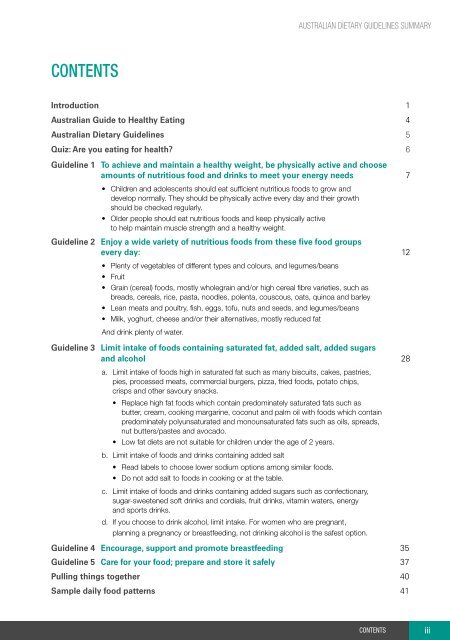Australian Dietary Guidelines - Summary - National Health and ...
Australian Dietary Guidelines - Summary - National Health and ...
Australian Dietary Guidelines - Summary - National Health and ...
- No tags were found...
Create successful ePaper yourself
Turn your PDF publications into a flip-book with our unique Google optimized e-Paper software.
<strong>Australian</strong> <strong>Dietary</strong> <strong>Guidelines</strong> <strong>Summary</strong>ContentsIntroduction 1<strong>Australian</strong> Guide to <strong>Health</strong>y Eating 4<strong>Australian</strong> <strong>Dietary</strong> <strong>Guidelines</strong> 5Quiz: Are you eating for health? 6Guideline 1 To achieve <strong>and</strong> maintain a healthy weight, be physically active <strong>and</strong> chooseamounts of nutritious food <strong>and</strong> drinks to meet your energy needs 7• Children <strong>and</strong> adolescents should eat sufficient nutritious foods to grow <strong>and</strong>develop normally. They should be physically active every day <strong>and</strong> their growthshould be checked regularly.• Older people should eat nutritious foods <strong>and</strong> keep physically activeto help maintain muscle strength <strong>and</strong> a healthy weight.Guideline 2 Enjoy a wide variety of nutritious foods from these five food groupsevery day: 12• Plenty of vegetables of different types <strong>and</strong> colours, <strong>and</strong> legumes/beans• Fruit• Grain (cereal) foods, mostly wholegrain <strong>and</strong>/or high cereal fibre varieties, such asbreads, cereals, rice, pasta, noodles, polenta, couscous, oats, quinoa <strong>and</strong> barley• Lean meats <strong>and</strong> poultry, fish, eggs, tofu, nuts <strong>and</strong> seeds, <strong>and</strong> legumes/beans• Milk, yoghurt, cheese <strong>and</strong>/or their alternatives, mostly reduced fatAnd drink plenty of water.Guideline 3 Limit intake of foods containing saturated fat, added salt, added sugars<strong>and</strong> alcohol 28a. Limit intake of foods high in saturated fat such as many biscuits, cakes, pastries,pies, processed meats, commercial burgers, pizza, fried foods, potato chips,crisps <strong>and</strong> other savoury snacks.• Replace high fat foods which contain predominately saturated fats such asbutter, cream, cooking margarine, coconut <strong>and</strong> palm oil with foods which containpredominately polyunsaturated <strong>and</strong> monounsaturated fats such as oils, spreads,nut butters/pastes <strong>and</strong> avocado.• Low fat diets are not suitable for children under the age of 2 years.b. Limit intake of foods <strong>and</strong> drinks containing added salt• Read labels to choose lower sodium options among similar foods.• Do not add salt to foods in cooking or at the table.c. Limit intake of foods <strong>and</strong> drinks containing added sugars such as confectionary,sugar-sweetened soft drinks <strong>and</strong> cordials, fruit drinks, vitamin waters, energy<strong>and</strong> sports drinks.d. If you choose to drink alcohol, limit intake. For women who are pregnant,planning a pregnancy or breastfeeding, not drinking alcohol is the safest option.Guideline 4 Encourage, support <strong>and</strong> promote breastfeeding 35Guideline 5 Care for your food; prepare <strong>and</strong> store it safely 37Pulling things together 40Sample daily food patterns 41CONTENTSiii
















